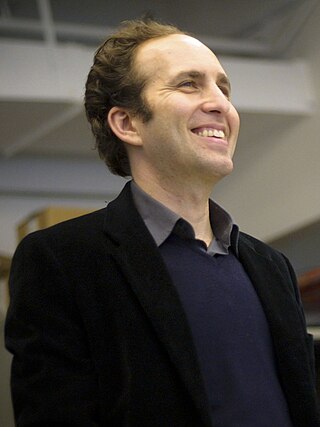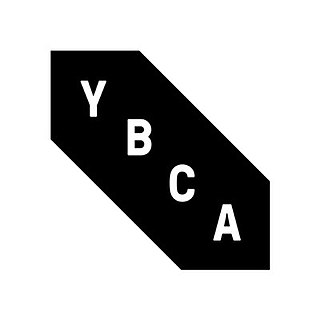
LA Freewaves, also known as Freewaves, is a Los Angeles–based nonprofit organization that exhibits multicultural, independent media and produces free public art projects to engage artists and audiences on current social issues. It was founded in 1989 by Anne Bray, the organization's executive director. With the support of others in the arts community, Freewaves presented its first exhibition of independent, multicultural video art at the November 1989 American Film Institute's (AFI) National Video Festival.

Scott Snibbe is an interactive media artist, author, entrepreneur, and meditation instructor who hosts the Skeptic's Path to Enlightenment meditation podcast. His first book, How to Train a Happy Mind, was released in 2024. Snibbe has collaborated with other artists and musicians, including Björk on her interactive “app album” Björk: Biophilia that was acquired by New York's MoMA as the first downloadable app in the museum's collection. Between 2000 and 2013 he founded several companies, including Eyegroove, which was acquired by Facebook in 2016. Early in his career, Snibbe was one of the developers of After Effects.

The Frameline Film Festival began as a storefront event in 1976. The first film festival, named the Gay Film Festival of Super-8 Films, was held in 1977. The festival is organized by Frameline, a nonprofit media arts organization whose mission statement is "to change the world through the power of queer cinema". It is the oldest LGBTQ+ film festival in the world.

Yerba Buena Center for the Arts (YBCA) is a multi-disciplinary contemporary arts center in San Francisco, California, United States. Located in Yerba Buena Gardens, YBCA features visual art, performance, and film/video that celebrates local, national, and international artists and the Bay Area's diverse communities. YBCA programs year-round in two landmark buildings—the Galleries and Forum by Japanese architect Fumihiko Maki and the adjacent Theater by American architect James Stewart Polshek and Todd Schliemann. Betti-Sue Hertz served as Curator from 2008 through 2015.

Visual Communications –– is a community-based non-profit media arts organization based in Los Angeles. It was founded in 1970 by independent filmmakers Robert Nakamura, Alan Ohashi, Eddie Wong, and Duane Kubo, who were students of EthnoCommunications, an alternative film school at University of California, Los Angeles. The mission of VC is to "promote intercultural understanding through the creation, presentation, preservation and support of media works by and about Asian Pacific Americans."

Kearny Street Workshop (KSW) in San Francisco, California, is the oldest multidisciplinary arts nonprofit addressing Asian Pacific American issues. The organization's mission is to produce and present art that enriches and empowers Asian Pacific American communities. Notable participants include author and Asian American studies scholar Russell Leong, playwright and author Jessica Hagedorn, author Janice Mirikitani, poet and historian Al Robles, and actor and filmmaker Lane Nishikawa.

The San Jose Museum of Quilts & Textiles is an art museum in Downtown San Jose, California, USA. Founded in 1977, the museum is the first in the United States devoted solely to quilts and textiles as an art form. Holdings include a permanent collection of over 1,000 quilts, garments and ethnic textiles, emphasizing artists of the 20th- and 21st-century, and a research library with over 500 books concerning the history and techniques of the craft.
New America Media (NAM) was a multimedia ethnic news agency and a coalition of ethnic media. Founded in 1996 by the nonprofit Pacific News Service, NAM was headquartered in San Francisco, with offices in Los Angeles, New York and Washington, D.C.
The Asian Arts Initiative (AAI) is a nonprofit organization in Philadelphia which focuses on art and the Asian-American community. It was founded by Gayle Isa, who also served as AAI's first executive director until June 2018. Its current executive director is Anne Ishii.
The Island Media Arts is a non-profit media organization that began with the Island which was incorporated in 1978 in Charlottetown, Prince Edward Island, Canada. The Island Media Arts evolved in 1982 when the co-op became oriented toward film production. Since then IMAC has operated as a non-profit filmmaker's organization. Though the emphasis on film has changed over time to branch into a wider array of media arts disciplines, the objectives have remained the same; to provide a space where artists can hone their skills and exchange ideas.
Knowbility is an American non-governmental organization based in Austin, Texas, working to support the independence and empowerment of people with disabilities by promoting the use and improving the availability of accessible information technology. Its mission is to create an inclusive digital world for people of all abilities. Knowbility's signature program is the Accessibility Internet Rally, a web-building competition that brings together volunteer web designers to create accessible websites for nonprofit organizations and artists that serve communities all over the world.

ZERO1: The Art and Technology Network is a 501(c)(3) non-profit organization dedicated to connecting creative explorers from art, science, and technology to provoke new ideas that serve to shape a more resilient future.
Take This Hammer is a 1964 American documentary film produced and directed by KQED (TV)'s Richard O. Moore for National Educational Television in 1963. The film first aired on February 4, 1964, in the Bay Area, at 7:30 pm on Ch.9 KQED.
Gray Area Foundation for the Arts, Inc. is a 501(c)3 non-profit art organization which hosts exhibitions, music events, software and electronics classes, a media lab, and a resident artist program.
Electronic Arts Intermix (EAI) is a nonprofit arts organization that is a resource for video and media art. An advocate of media art and artists since 1971, EAI's core program is the distribution and preservation of a collection of over 3,500 new and historical video works by artists. EAI has supported the creation, exhibition, distribution and preservation of video art, and more recently, digital art projects.
Women's Audio Mission is a non-profit organization and recording studio complex based in San Francisco and Oakland, California, whose mission is to promote "the advancement of women and gender-diverse people in music production and the recording arts."
The conservation and restoration of time-based media art is the practice of preserving time-based works of art. Preserving time-based media is a complex undertaking within the field of conservation that requires an understanding of both physical and digital conservation methods. It is the job of the conservator to evaluate possible changes made to the artwork over time. These changes could include short, medium, and long-term effects caused by the environment, exhibition-design, technicians, preferences, or technological development. The approach to each work is determined through various conservation and preservation strategies, continuous education and training, and resources available from institutions and organization across the globe.

The Oakland Asian Cultural Center, also referred to as the OACC, is an Oakland-based nonprofit cultural center that carries out Asian and Pacific Islander American arts and culture programs. It is located in the Pacific Renaissance Plaza in Oakland Chinatown, residing three blocks away from the 12th Street Civic Center BART station on Broadway.
Dawn Valadez is a Mexican-American documentary filmmaker and fundraiser based in the San Francisco Bay Area in California. She directed and produced the documentary film, Going On 13 (2008) and co-directed The Pushouts.
Rashaad Newsome is an American artist working at the intersection of technology, collage, sculpture, video, music, and performance. Newsome's work celebrates and abstracts Black and Queer contributions to the art canon, resulting in innovative and inclusive forms of culture and media. He lives and works in Oakland, California, and Brooklyn, New York.









